

(Got a lot of time and bandwidth? Then see David in 360 degrees by clicking here: )
Journeying southeast from the cathedral we passed the closed Museo Nazionale del Bargello, probably the world's best sculpture museum. We found many major attractions closed in Florence in November, part of the price we paid for not having to stand in line anywhere we went. (Rain and lack of daylight were other prices as well but, on balance, the tradeoffs were worth it. Then again, you wouldn't expect much of a line when the museum is closed, would you?).
A few blocks from the cathedral "square" lies the old political center of the city, the Piazza della Signoria, named after the ruling body of the town government (before the Medicis became de facto kings). Remnants of history litter this place reminding us of factions, church/state conflict, corrupt popes, the medieval equivalent of the religious right, and probably the most famous statue in the world (OK, a copy) of that guy at the top of the page.
The square started when the papal faction (called Guelfs) got rid of their rival emperor faction (called the Ghibellines). Supposedly the ins razed the buildings on the outs' land to build the plaza (piazza) and the town hall (called the Palazzo Vecchio -old palace) on the L-shaped area. The space holds four major attractions:
The piazza contains a number of statues, today mostly copies with the originals restored and placed in museums (including that curly headed guy at the top). The statue hated most is that of Neptune carved by Ammannati as a tribute to the Medici's naval ambitions (we mean the sea here, not reducing his abs). Sucking up was its own high renaissance art form in a scheming place like Florence and pictures of the Medici keep popping up in paintings. Michelangelo seemed to frequently have a catty remark on most other artists' work. He said of this figure of Neptune: "What a beautiful piece of marble you've ruined." (Reminds me of brother I had; I miss his remarks too). Florence has hated the Neptune statue ever since. Here it is, you be the judge:
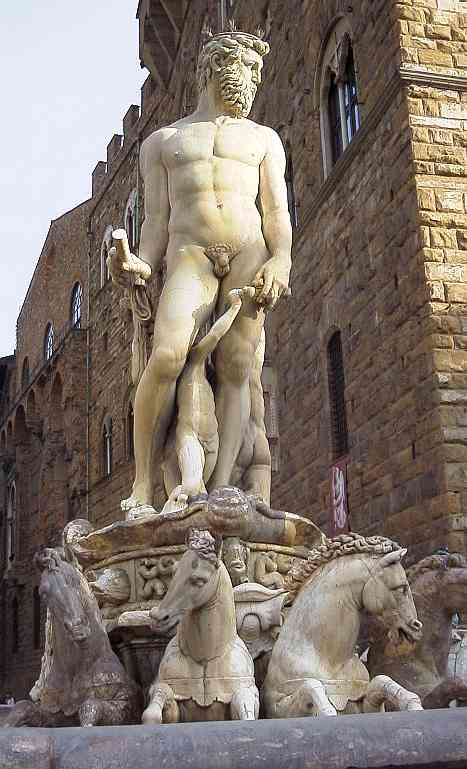
The sculptor Ammannati in his old age fell under the influence of the Jesuits and rejected his nude "pagan" statues of his early days. So this poor fountain isn't even loved by its creator! (Now you know why I'm not a sculptor.)
The statue sits on the spot where Florence's equivalent of the Ayatollah Khomeini was first hanged, then burnt. (Florence apparently wanted him really dead). History has treated this well-intentioned reformer (aren't we all!) almost as badly -- characterizing him as a prude and bookburner like the Talibans in Afghanistan. The invading French under Charles VIII interrupted the Medici's rule in 1494, effectively giving power to this Dominican preacher called Girolamo Savonarola who tried to root out the luxury and corruption of the city and of the church (earning him the enmity of the Borgia pope, the immensely corrupt Alexander VI).
Four four years, Savonarola's fiery voice filled the political void until his enemies in Florence and Rome brought him down (or should we say hanged him up). Savonarola established a democracy and created a "city of God" to lead Italy and reform the church. He was blamed for burning books and works of art in this square but this "bonfire of vanities" (yes, the term came from here and was only borrowed by Tom Wolfe) was more about burning pornography and gambling tables. He would do well in New Hampshire in February. (He lasted in power for four years -- same as did our most moral leader, Jimmy Carter.)
Events got the better of him and he himself was hanged and then burnt in the square in 1548. When you get people to start burning things, you don't know how far they'll go, especially with a firebrand. Today a plaque marks the approximate place of Savonarola's last stand. Not far from it is another symbol of the brief (about 40 years) Florentine republic underdog overcoming tyranny: Michelangelo's David. Another pub(l)ic hanging?
The Medicis returned a dozen years later and reestablished their power in such a ruthless way that an observer named Machiavelli memorialized them. (Turns out, Machiavelli was much more than an observer. He was the equivalent of secretary of state for Florence during the Republic. If Machiavelli is what those who favor democracy were like in Florence, you can imagine what the later Medici's were like.) Soon Florence's leadership in arts, finance, and the politics of Italy (and all of Europe) withered under the stifling Medici rule although they themselves clung to power for another 200 plus years, installed two of their clan in the papacy, gave two queens to France (who, in turn, started French cooking from Tuscan roots), and built the Ufrizzi palace which we will discuss below.
In the meantime, the Renaissance headed south to Rome as a succession of popes lured the artists away from Florence.
The Piazza della Signoria is bounded on the south by a loggia --an open porch popular in Mediterranean areas. This one, the Loggia dei Lanzi (named after the Swiss guards who protected the politicians). Its three large classical arches contain a sculpture patio, all of which are copies with the exception of this mannerist Rape of the Sabine, an episode from Roman history extracted from a single block of flawed marble by Giambologna .
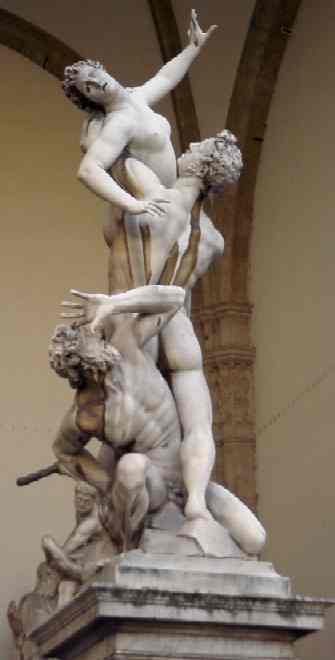
Looking from the Loggio to the Palazzo Vecchio, we see this lion (the symbol of Florence) by Donatello
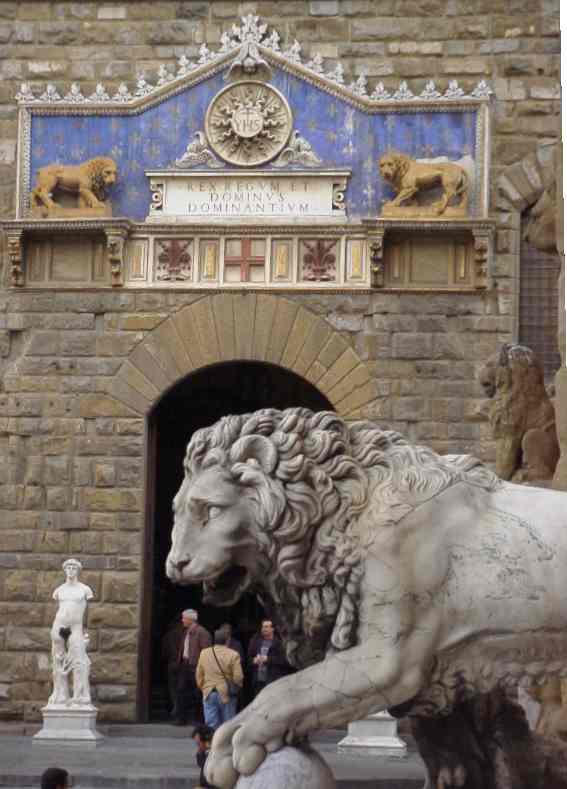
Another landmark with belfry jutting above the tightly packed Florentine houses is the tower of the Palazzo Vecchio (which means old palace when the Medicis had built their newer one). This is by far the most important secular building in Florence, perhaps in Italy after the Forum was demolished in Rome. Besides housing the Medici, the Signoria (sort of a city council) of the republic met here as did the Chamber of Deputies when Florence was briefly the capital of the united Italy about the time of the US's Civil War. Today it still functions as the town hall.
The outside is somewhat austere (a Florentine trick) with few windows or doors at the plaza level. Entering the Palazzo Vecchio, one encounters this 15th century Michelozzo/Vasari courtyard:
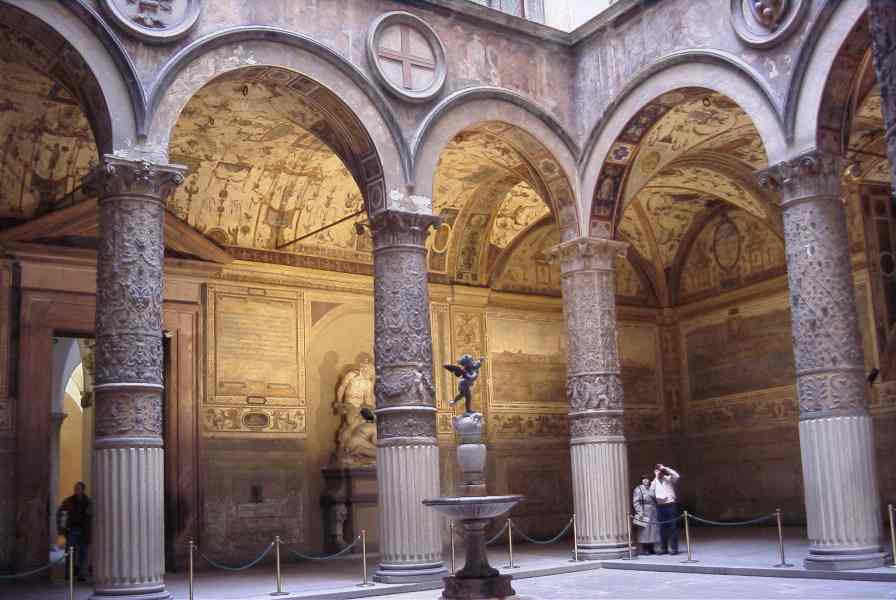
Going beyond the courtyard, one ascends a double staircase and enters the Hall of the Five Hundred (Salone del Cinquecentro) so called because of the 1500 members of the ruling council, only a third could fit into the room at one time. The walls are filled with sculpture and the ceiling by Vasari (the guy who clutters up his pictures, remember) looks like this:

The tour of the palace winds through many apartments (including Leo X, one of the Medici popes) over two floors. One of the last and most interesting rooms is the Map Chamber whose wallpaper consists of map of all of the known world at that time (16th century).
After touring the main palace, we entered the temporary exhibition space encouraged by an International Herald Tribune review extolling the virtues of the "Young Michelangelo" show. Supposedly this show would prove for all time that Michelangelo was trained. (He tried to give everyone the idea that he was a natural born genius -- not that hard to do when you create the Pieta at 19 and start David at 25). The show was a disappointment and we quickly found ourselves back on the street.
Our last stop was the Ufizzi Gallery, built originally as bureaucrat's office building (uffizi means offices in Italian) but now a premier art museum which in Italy means that it has a great collection, erratic hours, no air conditioning, and very little lighting (some rooms were nearly completely dark including Leonardo daVinci's room!). We made perhaps the biggest mistake of our trip figuring we could put this museum off until last in the day when we lost the daylight because any museum in the big leagues would have adequate artificial lighting. If you go there, go during daylight hours; this is Italy, after all.
One climbs a monumental staircase (again by Vasari) up it seems about a hundred stories (really three) and gradually descends. The place doesn't have Botticellis and Michelangelos, it has Botticelli rooms and Mechelangelo rooms. But because of the light, I could only rescue this one famous Botticelli picture of the Birth of Venus:
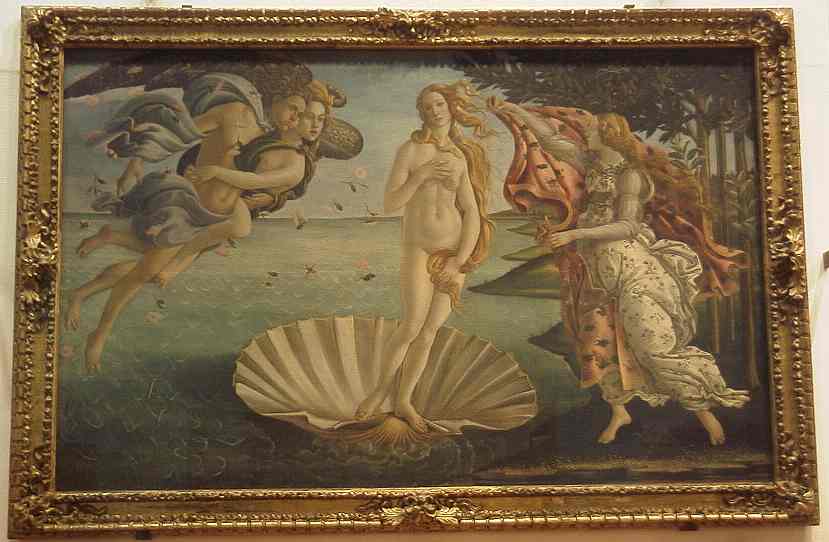
This is a great collection but the museum has had its troubles including a car bombing in 1993 that killed the museum curator and her family (still unsolved). Most of the west wing has been closed since.
As darkness descended, we found a guide-book quality restaurant and then took the long walk through the cobblestone streets, over the old bridge (Ponte Vecchio), around the castle walls, and up the hills to our hotel. The next morning our day started in Savonarola's backyard at the famous San Marco Convent. Please join us by clicking here:
Where do you want to go today? Here's a few choices:
